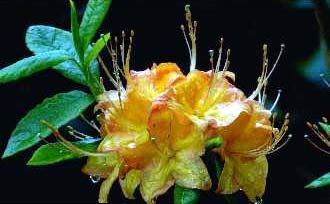Hedges have many uses, from bordering paths to creating a solid wall or barrier. Depending on the type of plants you choose, your hedge could provide you with a magnificent array of colorful blooms, leaves, and fruits, or a simple but elegant expanse of green.
You may want to plant a hedge to create privacy, to shape and define space, to mark a boundary, to hide unsightly views, or even to improve the climate and muffle noise in your yard. To form a hedge, you need only grow plants (usually shrubs) close together to form an unbroken line. Nearly any kind of shrub will make a good hedge.
Choosing the Right Shrub
Shrubs may be deciduous, and lose their leaves every fall, or evergreen, and keep their leaves year round. Deciduous shrubs are best known for their spring flowers. Evergreens come in 2 main categories—coniferous, which grow well in most climates, and broad-leaves, which are more delicate and usually require more mild weather.
There are many shrubs that have magnificent blooms and colorful leaves as well. Shrubs with colorful flowers include the common lilac (Syringa vulgaris), which produces lovely, wonderfully scented flowers in pink, violet, purple, white, and blue.
Plants with colorful foliage include the Japanese barberry, which has outstanding fall color and winter fruits, with red, yellow, and variegated-leafed cultivars. It also has dense foliage and is easy to grow. It is one of the most popular hedge and barrier plants.
Shrubs with showy fruits may be the most eye-catching choice for your hedge, as flowers may not always last long. Some fruits may last an entire fall or winter.
Finally, the evergreen euonymus is an ideal hedge - it is very tough and requires little maintenance. You can easily shear these plants closely, a quality useful for hedges.
If you choose flowering shrubs, pick colors that go well together. Also, plan complimentary foliage tones, as foliage comes in a vast array of colors, from pale green to purple and yellow. If you live in an area that has long winters, you may want to consider shrubs with colorful bark and long-lasting fruit, rather than shrubs with flowers. To find just the right choice for your garden, climate, and purpose, consult your local nursery.
Purchasing your Plants
Shrubs are most commonly sold in metal, plastic, or wooden containers. Shrubs in plastic containers are the easiest to remove without damaging the plants. When shopping, look for containers that are in good shape - rusted metal and split plastic may indicate the plant has been in the nursery too long. You may also buy shrubs balled and burlapped. These are available any time, but it is most common to purchase and plant in spring.
Deciduous plants that are popular for hedges are often available as bare-root plants. Bare-root plants are the most inexpensive, but they are only available during the dormant season. It is best to shop at the beginning of bare-root season – late winter or early spring - and look for plants that have several large, brown roots growing out from the main root.
Pruning Form Hedges
A newly planted hedge should grow without shearing for the first full season. This gives the roots a chance to get established. Trim lightly the second year, keeping a dense growth. When plants have finally reached the height you want, you may change your pruning techniques.
To maintain your hedge once it is established, shear small-leafed hedges, like boxwood or yew, when they look ragged, taking off almost all new growth. To avoid bare spots, however, always let the hedge retain a little bit of new growth.
After 10 to 15 years of slow growth, cut your hedge back severely one spring, and start over. Do not shear large-leaf hedges, like English laurel. Such plants may look butchered if you shear. Instead, you must prune one branch at a time with a pair of hand shears for an optimum look. Remember, hedges need to be "built" carefully. Do not let them grow too fast. Regular pruning will make your hedges sturdy.
Pests and Diseases
Shrubs are susceptible to various pests, including bark beetles, borers, sucking insects, caterpillars, snails, and slugs. The best way to avoid many of these problems is to keep your plant in good health, so it has good resistance. Also, be careful not to carelessly nick or "skin" your plant when pruning, as this could allow boring insects or fungi to enter.
How to Plant Colorful Hedges
Dig a trench the intended length of the hedge or dig individual holes. If you plant shrubs in a double, staggered row, you will have denser hedges more quickly than if you plant in a single row. The width of spacing should depend on the eventual branch spread. Most shrubs are not picky about soil and, once planted, require little maintenance other than pruning. For best results, water thoroughly, never shallowly. Depending on the shrub and the area, fertilize before or during active spring growth.
1. You may plant anytime soil is workable, although early spring and fall are preferable. Prune bare-root shrubs before planting. Prune tops of container plants only if you lose some root.
2. Dig a hole approximately twice as wide and deep as the root ball.
3. Place plants in hole. Be sure roots are not matted, but are allowed to radiate out. Fill soil to surrounding level. For burlapped shrubs, remove burlap if it is treated to retard rotting; otherwise, just untie and bury all edges.
4. Build a shallow basin around the shrub for water. Water thoroughly.
TIPS
1) If you plant one of the many varieties of fruit shrubs, your hedge can serve a dual purpose. Some favorites include apple trees, citrus trees, and Russian olives. A carefully shaped hedge will produce much more fruit than one that is sheared.
2) Before buying balled-and-burlapped shrubs, check to see if there is a well-developed network of roots. Avoid cracked, broken, or dry root balls.


